BMP3004 - World of Work: Motivation, Experiences, Coping Strategies
VerifiedAdded on 2023/06/18
|8
|2153
|326
Report
AI Summary
This report examines the concept of motivation in the workplace, drawing from theories like Maslow's hierarchy of needs. It identifies various factors that motivate employees, including salary, promotion opportunities, and a positive work environment. The report further analyzes the positive experiences employees gain from their job roles, such as performance management and skill development, alongside negative experiences like workplace conflicts and toxic environments. Finally, it proposes strategies for coping with negative factors, emphasizing employee engagement and recognition programs. Desklib offers this report as part of its collection of student-contributed assignments.
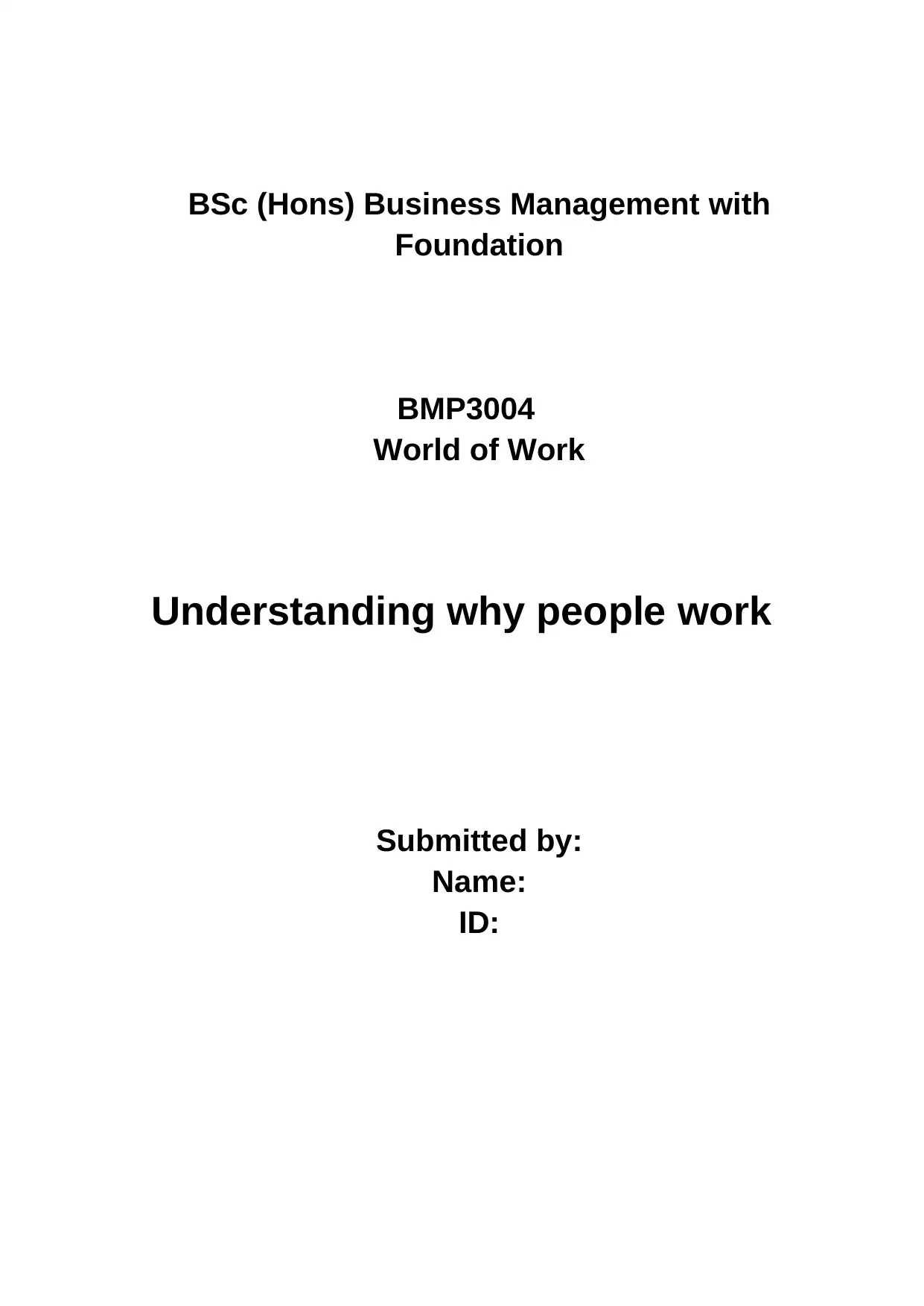
BSc (Hons) Business Management with
Foundation
BMP3004
World of Work
Understanding why people work
Submitted by:
Name:
ID:
Foundation
BMP3004
World of Work
Understanding why people work
Submitted by:
Name:
ID:
Paraphrase This Document
Need a fresh take? Get an instant paraphrase of this document with our AI Paraphraser
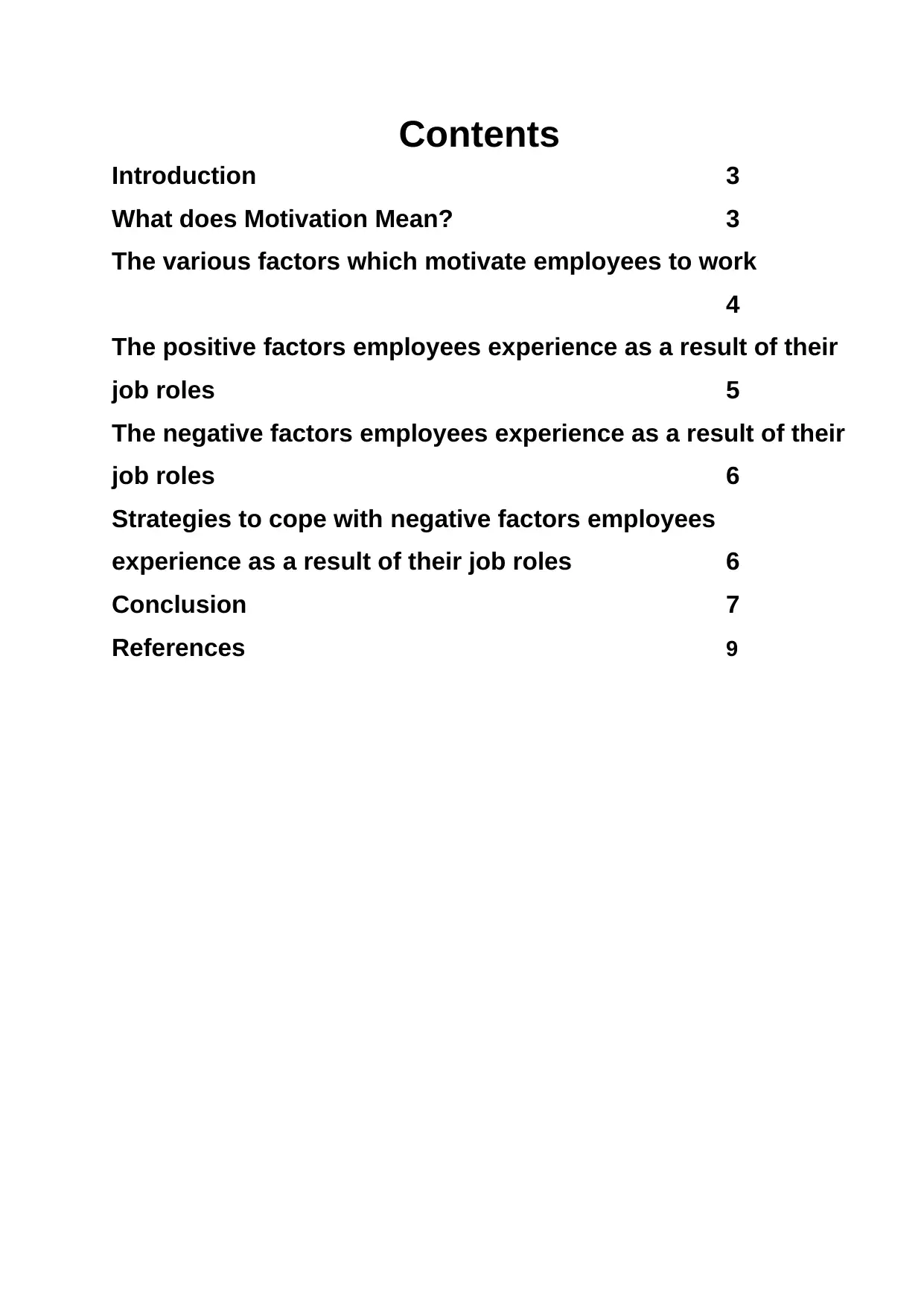
Contents
Introduction 3
What does Motivation Mean? 3
The various factors which motivate employees to work
4
The positive factors employees experience as a result of their
job roles 5
The negative factors employees experience as a result of their
job roles 6
Strategies to cope with negative factors employees
experience as a result of their job roles 6
Conclusion 7
References 9
Introduction 3
What does Motivation Mean? 3
The various factors which motivate employees to work
4
The positive factors employees experience as a result of their
job roles 5
The negative factors employees experience as a result of their
job roles 6
Strategies to cope with negative factors employees
experience as a result of their job roles 6
Conclusion 7
References 9
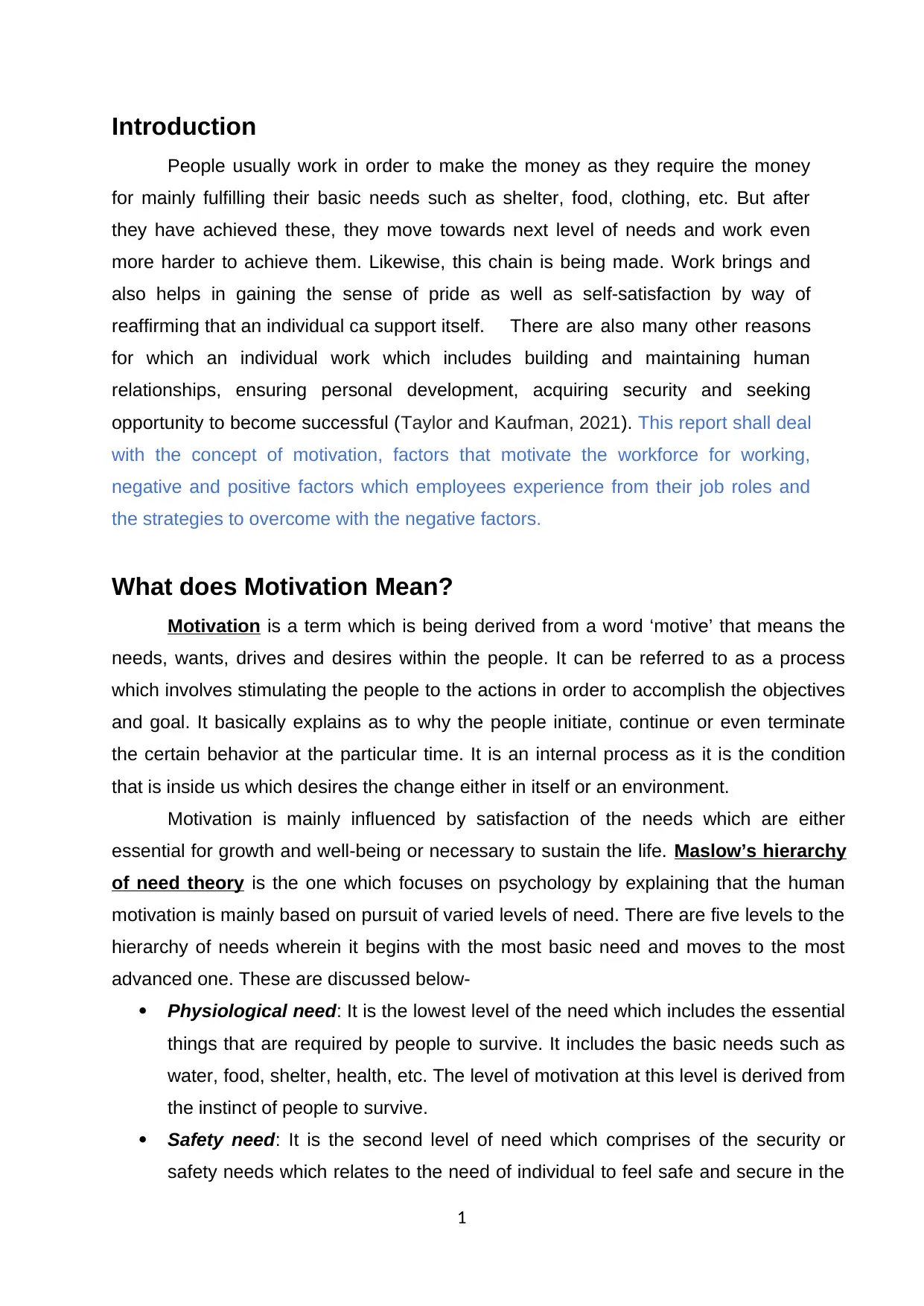
Introduction
People usually work in order to make the money as they require the money
for mainly fulfilling their basic needs such as shelter, food, clothing, etc. But after
they have achieved these, they move towards next level of needs and work even
more harder to achieve them. Likewise, this chain is being made. Work brings and
also helps in gaining the sense of pride as well as self-satisfaction by way of
reaffirming that an individual ca support itself. There are also many other reasons
for which an individual work which includes building and maintaining human
relationships, ensuring personal development, acquiring security and seeking
opportunity to become successful (Taylor and Kaufman, 2021). This report shall deal
with the concept of motivation, factors that motivate the workforce for working,
negative and positive factors which employees experience from their job roles and
the strategies to overcome with the negative factors.
What does Motivation Mean?
Motivation is a term which is being derived from a word ‘motive’ that means the
needs, wants, drives and desires within the people. It can be referred to as a process
which involves stimulating the people to the actions in order to accomplish the objectives
and goal. It basically explains as to why the people initiate, continue or even terminate
the certain behavior at the particular time. It is an internal process as it is the condition
that is inside us which desires the change either in itself or an environment.
Motivation is mainly influenced by satisfaction of the needs which are either
essential for growth and well-being or necessary to sustain the life. Maslow’s hierarchy
of need theory is the one which focuses on psychology by explaining that the human
motivation is mainly based on pursuit of varied levels of need. There are five levels to the
hierarchy of needs wherein it begins with the most basic need and moves to the most
advanced one. These are discussed below-
Physiological need: It is the lowest level of the need which includes the essential
things that are required by people to survive. It includes the basic needs such as
water, food, shelter, health, etc. The level of motivation at this level is derived from
the instinct of people to survive.
Safety need: It is the second level of need which comprises of the security or
safety needs which relates to the need of individual to feel safe and secure in the
1
People usually work in order to make the money as they require the money
for mainly fulfilling their basic needs such as shelter, food, clothing, etc. But after
they have achieved these, they move towards next level of needs and work even
more harder to achieve them. Likewise, this chain is being made. Work brings and
also helps in gaining the sense of pride as well as self-satisfaction by way of
reaffirming that an individual ca support itself. There are also many other reasons
for which an individual work which includes building and maintaining human
relationships, ensuring personal development, acquiring security and seeking
opportunity to become successful (Taylor and Kaufman, 2021). This report shall deal
with the concept of motivation, factors that motivate the workforce for working,
negative and positive factors which employees experience from their job roles and
the strategies to overcome with the negative factors.
What does Motivation Mean?
Motivation is a term which is being derived from a word ‘motive’ that means the
needs, wants, drives and desires within the people. It can be referred to as a process
which involves stimulating the people to the actions in order to accomplish the objectives
and goal. It basically explains as to why the people initiate, continue or even terminate
the certain behavior at the particular time. It is an internal process as it is the condition
that is inside us which desires the change either in itself or an environment.
Motivation is mainly influenced by satisfaction of the needs which are either
essential for growth and well-being or necessary to sustain the life. Maslow’s hierarchy
of need theory is the one which focuses on psychology by explaining that the human
motivation is mainly based on pursuit of varied levels of need. There are five levels to the
hierarchy of needs wherein it begins with the most basic need and moves to the most
advanced one. These are discussed below-
Physiological need: It is the lowest level of the need which includes the essential
things that are required by people to survive. It includes the basic needs such as
water, food, shelter, health, etc. The level of motivation at this level is derived from
the instinct of people to survive.
Safety need: It is the second level of need which comprises of the security or
safety needs which relates to the need of individual to feel safe and secure in the
1
⊘ This is a preview!⊘
Do you want full access?
Subscribe today to unlock all pages.

Trusted by 1+ million students worldwide
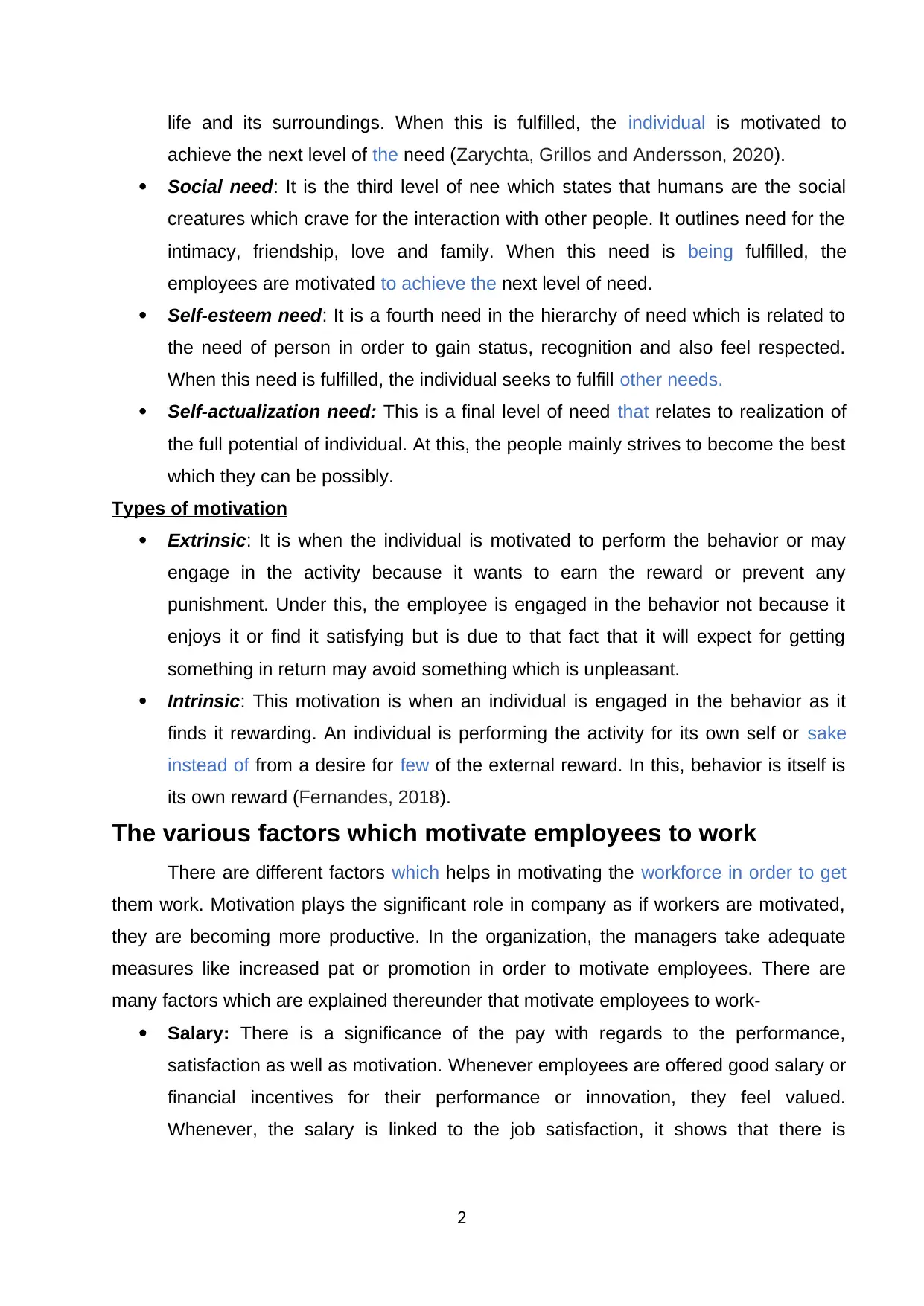
life and its surroundings. When this is fulfilled, the individual is motivated to
achieve the next level of the need (Zarychta, Grillos and Andersson, 2020).
Social need: It is the third level of nee which states that humans are the social
creatures which crave for the interaction with other people. It outlines need for the
intimacy, friendship, love and family. When this need is being fulfilled, the
employees are motivated to achieve the next level of need.
Self-esteem need: It is a fourth need in the hierarchy of need which is related to
the need of person in order to gain status, recognition and also feel respected.
When this need is fulfilled, the individual seeks to fulfill other needs.
Self-actualization need: This is a final level of need that relates to realization of
the full potential of individual. At this, the people mainly strives to become the best
which they can be possibly.
Types of motivation
Extrinsic: It is when the individual is motivated to perform the behavior or may
engage in the activity because it wants to earn the reward or prevent any
punishment. Under this, the employee is engaged in the behavior not because it
enjoys it or find it satisfying but is due to that fact that it will expect for getting
something in return may avoid something which is unpleasant.
Intrinsic: This motivation is when an individual is engaged in the behavior as it
finds it rewarding. An individual is performing the activity for its own self or sake
instead of from a desire for few of the external reward. In this, behavior is itself is
its own reward (Fernandes, 2018).
The various factors which motivate employees to work
There are different factors which helps in motivating the workforce in order to get
them work. Motivation plays the significant role in company as if workers are motivated,
they are becoming more productive. In the organization, the managers take adequate
measures like increased pat or promotion in order to motivate employees. There are
many factors which are explained thereunder that motivate employees to work-
Salary: There is a significance of the pay with regards to the performance,
satisfaction as well as motivation. Whenever employees are offered good salary or
financial incentives for their performance or innovation, they feel valued.
Whenever, the salary is linked to the job satisfaction, it shows that there is
2
achieve the next level of the need (Zarychta, Grillos and Andersson, 2020).
Social need: It is the third level of nee which states that humans are the social
creatures which crave for the interaction with other people. It outlines need for the
intimacy, friendship, love and family. When this need is being fulfilled, the
employees are motivated to achieve the next level of need.
Self-esteem need: It is a fourth need in the hierarchy of need which is related to
the need of person in order to gain status, recognition and also feel respected.
When this need is fulfilled, the individual seeks to fulfill other needs.
Self-actualization need: This is a final level of need that relates to realization of
the full potential of individual. At this, the people mainly strives to become the best
which they can be possibly.
Types of motivation
Extrinsic: It is when the individual is motivated to perform the behavior or may
engage in the activity because it wants to earn the reward or prevent any
punishment. Under this, the employee is engaged in the behavior not because it
enjoys it or find it satisfying but is due to that fact that it will expect for getting
something in return may avoid something which is unpleasant.
Intrinsic: This motivation is when an individual is engaged in the behavior as it
finds it rewarding. An individual is performing the activity for its own self or sake
instead of from a desire for few of the external reward. In this, behavior is itself is
its own reward (Fernandes, 2018).
The various factors which motivate employees to work
There are different factors which helps in motivating the workforce in order to get
them work. Motivation plays the significant role in company as if workers are motivated,
they are becoming more productive. In the organization, the managers take adequate
measures like increased pat or promotion in order to motivate employees. There are
many factors which are explained thereunder that motivate employees to work-
Salary: There is a significance of the pay with regards to the performance,
satisfaction as well as motivation. Whenever employees are offered good salary or
financial incentives for their performance or innovation, they feel valued.
Whenever, the salary is linked to the job satisfaction, it shows that there is
2
Paraphrase This Document
Need a fresh take? Get an instant paraphrase of this document with our AI Paraphraser
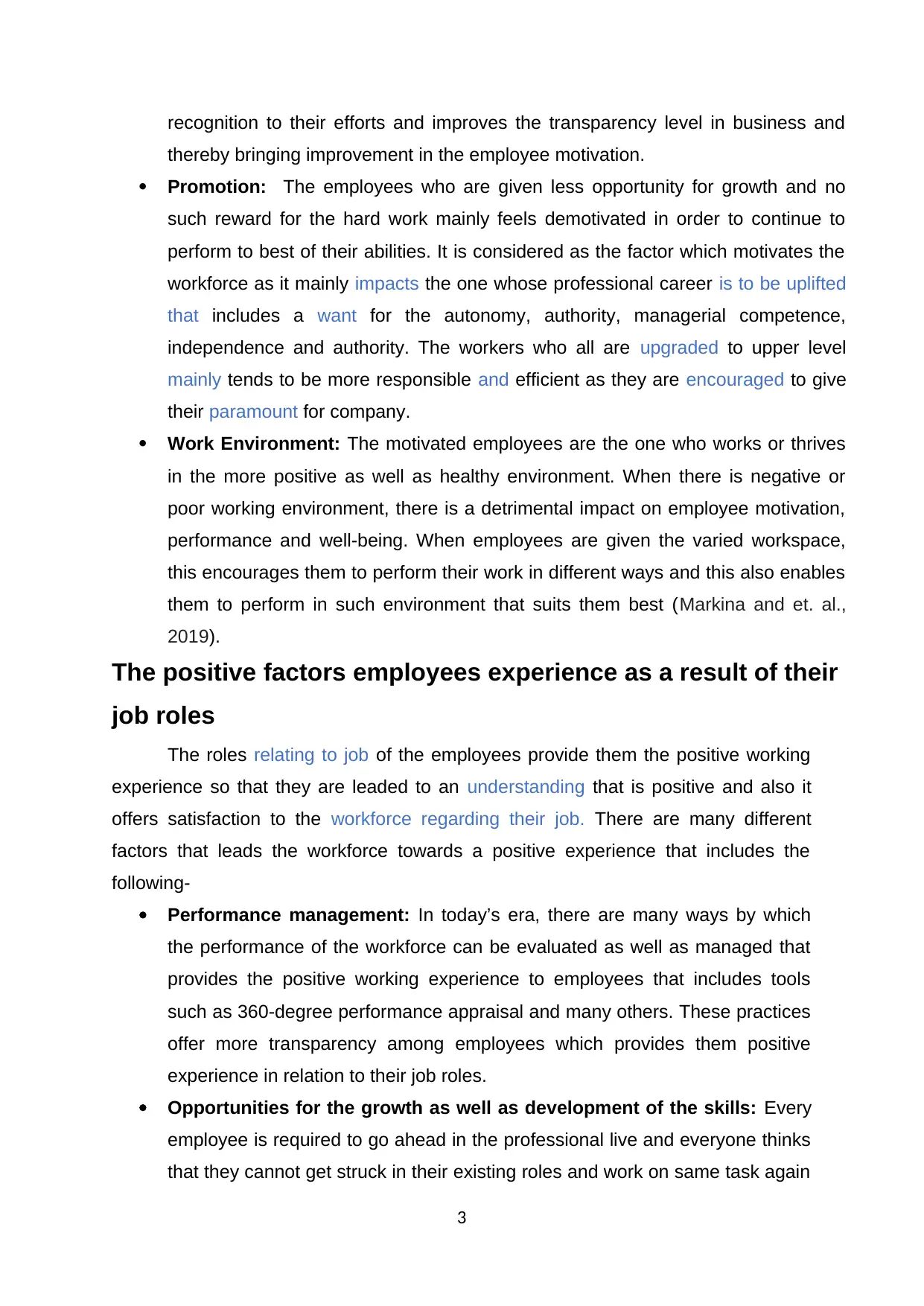
recognition to their efforts and improves the transparency level in business and
thereby bringing improvement in the employee motivation.
Promotion: The employees who are given less opportunity for growth and no
such reward for the hard work mainly feels demotivated in order to continue to
perform to best of their abilities. It is considered as the factor which motivates the
workforce as it mainly impacts the one whose professional career is to be uplifted
that includes a want for the autonomy, authority, managerial competence,
independence and authority. The workers who all are upgraded to upper level
mainly tends to be more responsible and efficient as they are encouraged to give
their paramount for company.
Work Environment: The motivated employees are the one who works or thrives
in the more positive as well as healthy environment. When there is negative or
poor working environment, there is a detrimental impact on employee motivation,
performance and well-being. When employees are given the varied workspace,
this encourages them to perform their work in different ways and this also enables
them to perform in such environment that suits them best (Markina and et. al.,
2019).
The positive factors employees experience as a result of their
job roles
The roles relating to job of the employees provide them the positive working
experience so that they are leaded to an understanding that is positive and also it
offers satisfaction to the workforce regarding their job. There are many different
factors that leads the workforce towards a positive experience that includes the
following-
Performance management: In today’s era, there are many ways by which
the performance of the workforce can be evaluated as well as managed that
provides the positive working experience to employees that includes tools
such as 360-degree performance appraisal and many others. These practices
offer more transparency among employees which provides them positive
experience in relation to their job roles.
Opportunities for the growth as well as development of the skills: Every
employee is required to go ahead in the professional live and everyone thinks
that they cannot get struck in their existing roles and work on same task again
3
thereby bringing improvement in the employee motivation.
Promotion: The employees who are given less opportunity for growth and no
such reward for the hard work mainly feels demotivated in order to continue to
perform to best of their abilities. It is considered as the factor which motivates the
workforce as it mainly impacts the one whose professional career is to be uplifted
that includes a want for the autonomy, authority, managerial competence,
independence and authority. The workers who all are upgraded to upper level
mainly tends to be more responsible and efficient as they are encouraged to give
their paramount for company.
Work Environment: The motivated employees are the one who works or thrives
in the more positive as well as healthy environment. When there is negative or
poor working environment, there is a detrimental impact on employee motivation,
performance and well-being. When employees are given the varied workspace,
this encourages them to perform their work in different ways and this also enables
them to perform in such environment that suits them best (Markina and et. al.,
2019).
The positive factors employees experience as a result of their
job roles
The roles relating to job of the employees provide them the positive working
experience so that they are leaded to an understanding that is positive and also it
offers satisfaction to the workforce regarding their job. There are many different
factors that leads the workforce towards a positive experience that includes the
following-
Performance management: In today’s era, there are many ways by which
the performance of the workforce can be evaluated as well as managed that
provides the positive working experience to employees that includes tools
such as 360-degree performance appraisal and many others. These practices
offer more transparency among employees which provides them positive
experience in relation to their job roles.
Opportunities for the growth as well as development of the skills: Every
employee is required to go ahead in the professional live and everyone thinks
that they cannot get struck in their existing roles and work on same task again
3
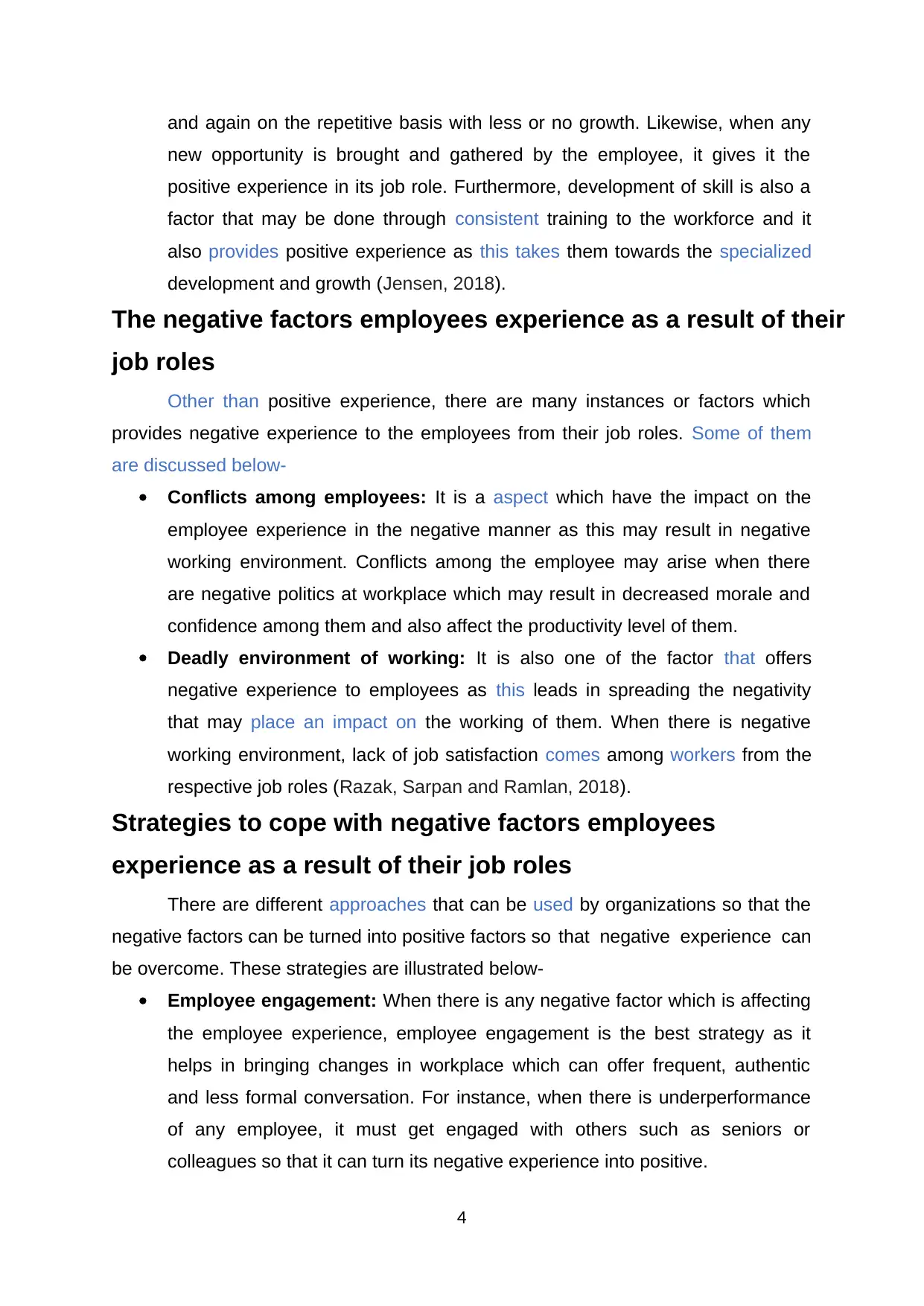
and again on the repetitive basis with less or no growth. Likewise, when any
new opportunity is brought and gathered by the employee, it gives it the
positive experience in its job role. Furthermore, development of skill is also a
factor that may be done through consistent training to the workforce and it
also provides positive experience as this takes them towards the specialized
development and growth (Jensen, 2018).
The negative factors employees experience as a result of their
job roles
Other than positive experience, there are many instances or factors which
provides negative experience to the employees from their job roles. Some of them
are discussed below-
Conflicts among employees: It is a aspect which have the impact on the
employee experience in the negative manner as this may result in negative
working environment. Conflicts among the employee may arise when there
are negative politics at workplace which may result in decreased morale and
confidence among them and also affect the productivity level of them.
Deadly environment of working: It is also one of the factor that offers
negative experience to employees as this leads in spreading the negativity
that may place an impact on the working of them. When there is negative
working environment, lack of job satisfaction comes among workers from the
respective job roles (Razak, Sarpan and Ramlan, 2018).
Strategies to cope with negative factors employees
experience as a result of their job roles
There are different approaches that can be used by organizations so that the
negative factors can be turned into positive factors so that negative experience can
be overcome. These strategies are illustrated below-
Employee engagement: When there is any negative factor which is affecting
the employee experience, employee engagement is the best strategy as it
helps in bringing changes in workplace which can offer frequent, authentic
and less formal conversation. For instance, when there is underperformance
of any employee, it must get engaged with others such as seniors or
colleagues so that it can turn its negative experience into positive.
4
new opportunity is brought and gathered by the employee, it gives it the
positive experience in its job role. Furthermore, development of skill is also a
factor that may be done through consistent training to the workforce and it
also provides positive experience as this takes them towards the specialized
development and growth (Jensen, 2018).
The negative factors employees experience as a result of their
job roles
Other than positive experience, there are many instances or factors which
provides negative experience to the employees from their job roles. Some of them
are discussed below-
Conflicts among employees: It is a aspect which have the impact on the
employee experience in the negative manner as this may result in negative
working environment. Conflicts among the employee may arise when there
are negative politics at workplace which may result in decreased morale and
confidence among them and also affect the productivity level of them.
Deadly environment of working: It is also one of the factor that offers
negative experience to employees as this leads in spreading the negativity
that may place an impact on the working of them. When there is negative
working environment, lack of job satisfaction comes among workers from the
respective job roles (Razak, Sarpan and Ramlan, 2018).
Strategies to cope with negative factors employees
experience as a result of their job roles
There are different approaches that can be used by organizations so that the
negative factors can be turned into positive factors so that negative experience can
be overcome. These strategies are illustrated below-
Employee engagement: When there is any negative factor which is affecting
the employee experience, employee engagement is the best strategy as it
helps in bringing changes in workplace which can offer frequent, authentic
and less formal conversation. For instance, when there is underperformance
of any employee, it must get engaged with others such as seniors or
colleagues so that it can turn its negative experience into positive.
4
⊘ This is a preview!⊘
Do you want full access?
Subscribe today to unlock all pages.

Trusted by 1+ million students worldwide
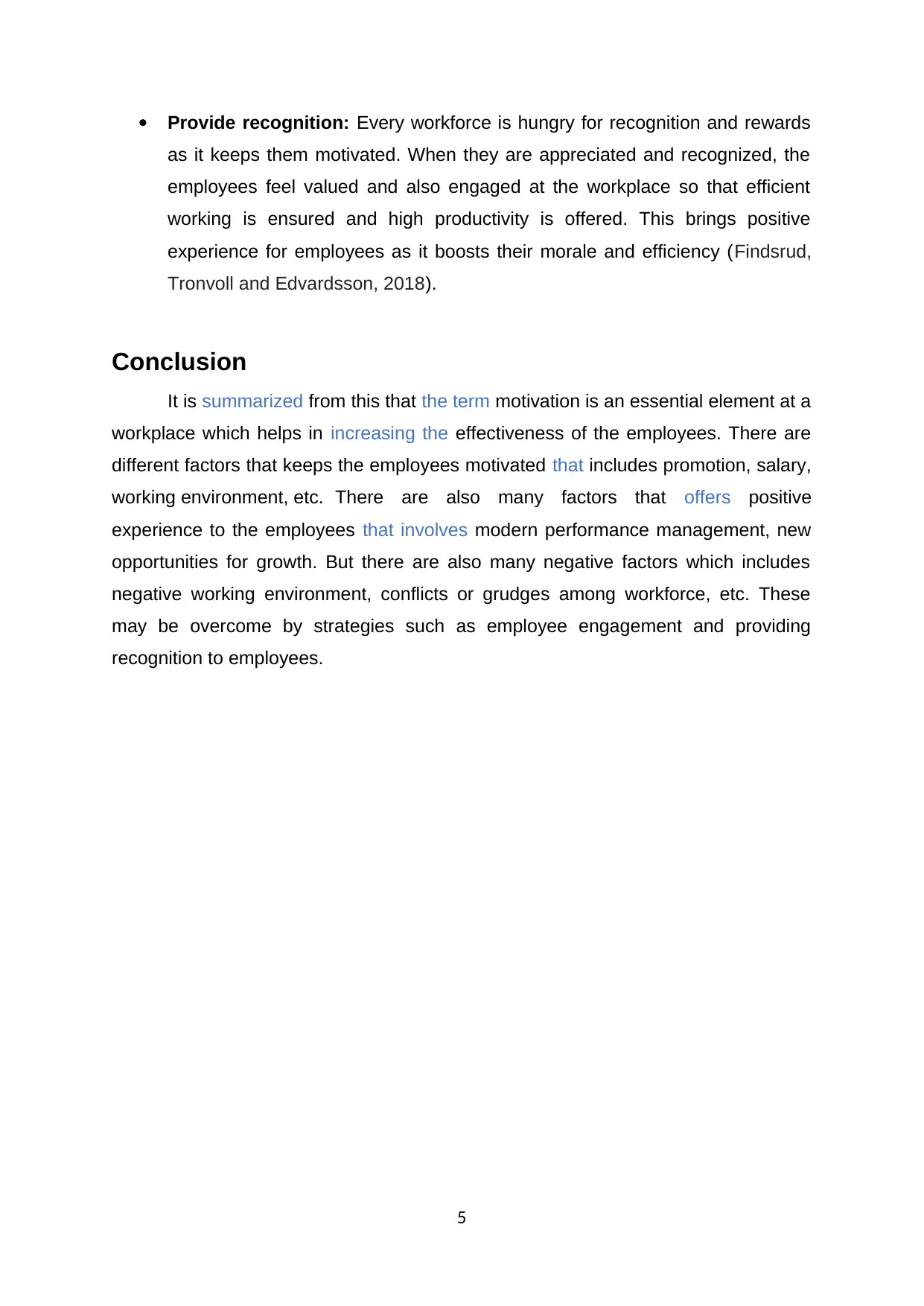
Provide recognition: Every workforce is hungry for recognition and rewards
as it keeps them motivated. When they are appreciated and recognized, the
employees feel valued and also engaged at the workplace so that efficient
working is ensured and high productivity is offered. This brings positive
experience for employees as it boosts their morale and efficiency (Findsrud,
Tronvoll and Edvardsson, 2018).
Conclusion
It is summarized from this that the term motivation is an essential element at a
workplace which helps in increasing the effectiveness of the employees. There are
different factors that keeps the employees motivated that includes promotion, salary,
working environment, etc. There are also many factors that offers positive
experience to the employees that involves modern performance management, new
opportunities for growth. But there are also many negative factors which includes
negative working environment, conflicts or grudges among workforce, etc. These
may be overcome by strategies such as employee engagement and providing
recognition to employees.
5
as it keeps them motivated. When they are appreciated and recognized, the
employees feel valued and also engaged at the workplace so that efficient
working is ensured and high productivity is offered. This brings positive
experience for employees as it boosts their morale and efficiency (Findsrud,
Tronvoll and Edvardsson, 2018).
Conclusion
It is summarized from this that the term motivation is an essential element at a
workplace which helps in increasing the effectiveness of the employees. There are
different factors that keeps the employees motivated that includes promotion, salary,
working environment, etc. There are also many factors that offers positive
experience to the employees that involves modern performance management, new
opportunities for growth. But there are also many negative factors which includes
negative working environment, conflicts or grudges among workforce, etc. These
may be overcome by strategies such as employee engagement and providing
recognition to employees.
5
Paraphrase This Document
Need a fresh take? Get an instant paraphrase of this document with our AI Paraphraser
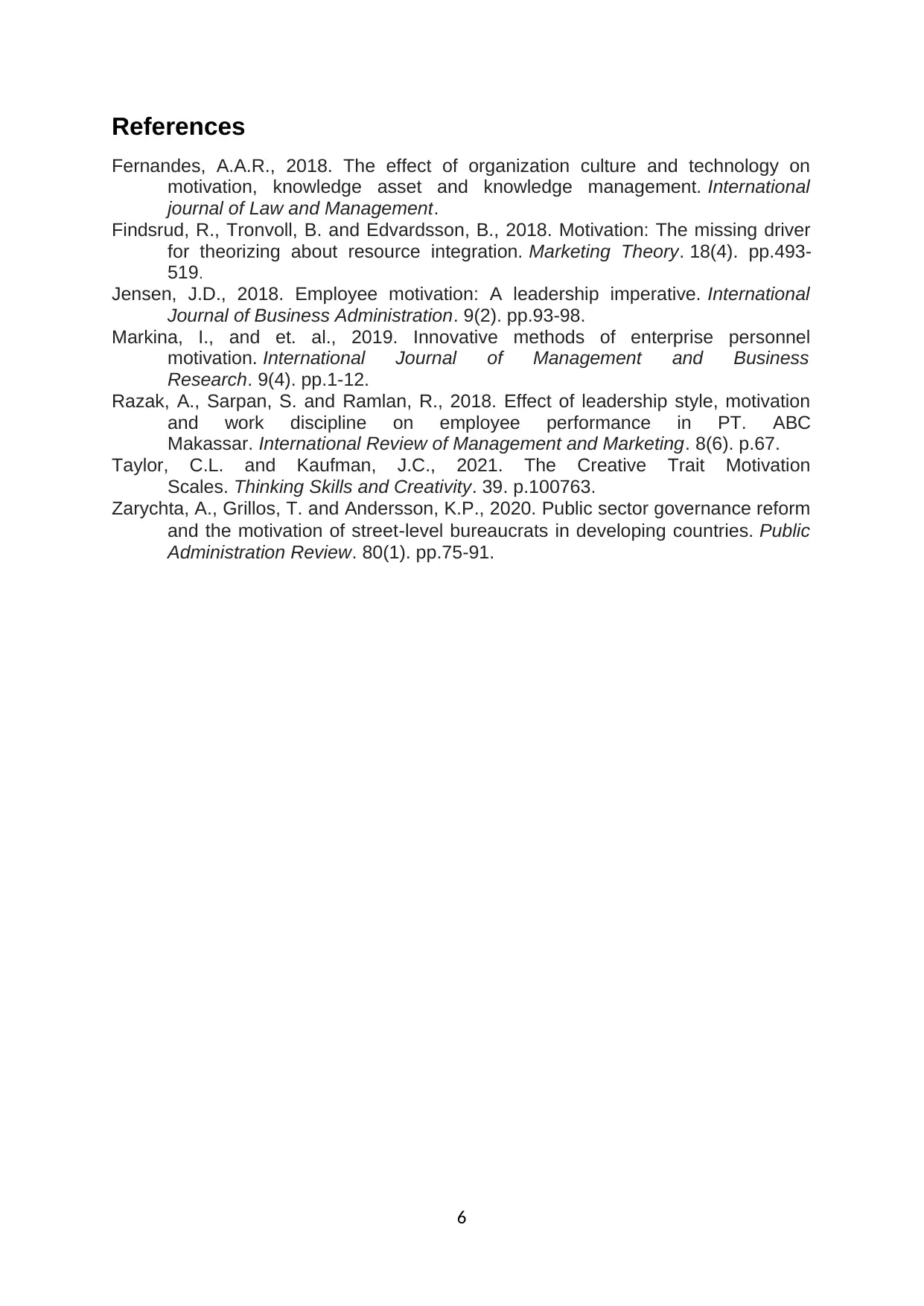
References
Fernandes, A.A.R., 2018. The effect of organization culture and technology on
motivation, knowledge asset and knowledge management. International
journal of Law and Management.
Findsrud, R., Tronvoll, B. and Edvardsson, B., 2018. Motivation: The missing driver
for theorizing about resource integration. Marketing Theory. 18(4). pp.493-
519.
Jensen, J.D., 2018. Employee motivation: A leadership imperative. International
Journal of Business Administration. 9(2). pp.93-98.
Markina, I., and et. al., 2019. Innovative methods of enterprise personnel
motivation. International Journal of Management and Business
Research. 9(4). pp.1-12.
Razak, A., Sarpan, S. and Ramlan, R., 2018. Effect of leadership style, motivation
and work discipline on employee performance in PT. ABC
Makassar. International Review of Management and Marketing. 8(6). p.67.
Taylor, C.L. and Kaufman, J.C., 2021. The Creative Trait Motivation
Scales. Thinking Skills and Creativity. 39. p.100763.
Zarychta, A., Grillos, T. and Andersson, K.P., 2020. Public sector governance reform
and the motivation of street‐level bureaucrats in developing countries. Public
Administration Review. 80(1). pp.75-91.
6
Fernandes, A.A.R., 2018. The effect of organization culture and technology on
motivation, knowledge asset and knowledge management. International
journal of Law and Management.
Findsrud, R., Tronvoll, B. and Edvardsson, B., 2018. Motivation: The missing driver
for theorizing about resource integration. Marketing Theory. 18(4). pp.493-
519.
Jensen, J.D., 2018. Employee motivation: A leadership imperative. International
Journal of Business Administration. 9(2). pp.93-98.
Markina, I., and et. al., 2019. Innovative methods of enterprise personnel
motivation. International Journal of Management and Business
Research. 9(4). pp.1-12.
Razak, A., Sarpan, S. and Ramlan, R., 2018. Effect of leadership style, motivation
and work discipline on employee performance in PT. ABC
Makassar. International Review of Management and Marketing. 8(6). p.67.
Taylor, C.L. and Kaufman, J.C., 2021. The Creative Trait Motivation
Scales. Thinking Skills and Creativity. 39. p.100763.
Zarychta, A., Grillos, T. and Andersson, K.P., 2020. Public sector governance reform
and the motivation of street‐level bureaucrats in developing countries. Public
Administration Review. 80(1). pp.75-91.
6
1 out of 8
Related Documents
Your All-in-One AI-Powered Toolkit for Academic Success.
+13062052269
info@desklib.com
Available 24*7 on WhatsApp / Email
![[object Object]](/_next/static/media/star-bottom.7253800d.svg)
Unlock your academic potential
Copyright © 2020–2025 A2Z Services. All Rights Reserved. Developed and managed by ZUCOL.



